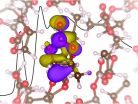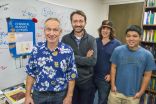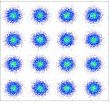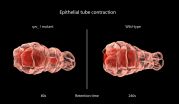(Press-News.org) The lithium-ion batteries that mobilize our electronic devices need to be improved if they are to power electric vehicles or
store electrical energy for the grid. Berkeley Lab researchers looking for a better understanding of liquid electrolyte may have found a pathway forward. A team led by Richard Saykally, a chemist with Berkeley Lab's Chemical Sciences Division, David Prendergast, a theorist with Berkeley Lab's Molecular Foundry, and Steven Harris, a chemist with the Lab's Materials Sciences Division, found surprising results in the first X-ray absorption spectroscopy study of a model lithium electrolyte.
"A crucial process in lithium ion batteries is the transport of lithium ions between the electrodes," explains Saykally. "Commercial lithium-ion batteries contain a liquid electrolyte comprising a lithium salt dissolved in an alkyl carbonate solvent system. There's disagreement in the battery industry on the nature of the local solvation environment of lithium ions in these solutions, a critical issue because the desolvation of the ions as they move through the negative electrode is believed to limit the electrical power that can be made available."
Most previous computational simulations have predicted a tetrahedral solvation structure for the lithium ion in the electrolyte, but the new study by Saykally, Prendergast, Harris and their collaborators show this to not be the case.
"Our results indicate a solvation number of 4.5, which points to a non-tetrahedral solvation structure for the lithium ions," says lithium-battery expert Harris. "This contradicts numerous theoretical studies which indicated a primarily tetrahedral coordination structure with a solvation number near 2 or 3, depending on the prevalence of ion pairing. Based on our results, to design better performing electrolytes, future computational models will need to move beyond tetrahedral coordination structures."
Lithium-ion batteries (LIBs) make any short list of great inventions of the 20th century. Today LIBs represent a multibillion dollar industry as the power supply of cellular phones, tablets, laptops and other handheld electronic devices. However, serious shortcomings - high costs, inadequate energy densities, long recharge times and short cycle-life times - have hampered the use of LIBS for electric vehicles and for efficient electrical energy storage systems that can be used in conjunction with wind and solar energy sources.
Although it has become increasingly clear to the battery industry that improvements in the liquid electrolyte are essential if LIBs are to be effective for electric vehicles and large-scale energy storage, most LIB research has focused on the electrodes and solid electrolyte interphase. The problem has been a lack of capabilities for the requisite experiments, particularly X-ray spectroscopy.
This deficiency was addressed by Saykally and his group with their development of a unique liquid microjet technology in which two aqueous samples rapidly mix and flow through a finely tipped silica nozzle only a few micrometers in diameter. The resulting liquid beam travels a few centimeters in a vacuum chamber before it is intersected by an X-ray beam then collected and condensed out. This liquid microjet system has been set up at Beamline 8.0.1 of Berkeley Lab's Advanced Light Source (ALS). Beamline 8.0.1 is a high flux undulator beamline that produces X-ray beams optimized for X-ray spectroscopy.
"Working at the ALS with our liquid microjet system, we used X-ray absorption spectroscopy to study lithium tetrafluoroborate in propylene carbonate," Saykally says. "X-ray absorption spectroscopy is an atom-specific core-level spectroscopic probe of unoccupied electronic states. It is highly sensitive to both the intra- and intermolecular environment of the target atom."
INFORMATION:
The XAS experimental spectra were interpreted through molecular dynamics and density functional theory spectral simulations carried out on the supercomputers at the National Energy Research Scientific Computing Center (NERSC) by Prendergast and Jacob Smith, a graduate student in Saykally's research group. The ALS, the Molecular Foundry and NERSC are all DOE Office of Science national user facilities hosted at Berkeley Lab.
A paper describing this research has been published in the journal Physical Chemistry Chemical Physics. The paper is titled, "X-Ray absorption spectroscopy of LiBF4 in propylene carbonate: a model lithium ion battery electrolyte." Saykally is the corresponding author, Smith the lead author. Other co-authors in addition to Harris and Prendergast were Royce Lam, Alex Sheardy, Orion Shih, Anthony Rizzuto and Oleg Borodin.
This research was supported by the DOE Office of Science.
Lawrence Berkeley National Laboratory addresses the world's most urgent scientific challenges by advancing sustainable energy, protecting human health, creating new materials, and revealing the origin and fate of the universe. Founded in 1931, Berkeley Lab's scientific expertise has been recognized with 13 Nobel prizes. The University of California manages Berkeley Lab for the U.S. Department of Energy's Office of Science. For more, visit http://www.lbl.gov.
DOE's Office of Science is the single largest supporter of basic research in the physical sciences in the United States, and is working to address some of the most pressing challenges of our time. For more information, please visit the Office of Science website at science.energy.gov/.
It's like a scene from a gamer's wildest dreams: 12 high-definition, 55-inch 3D televisions all connected to a computer capable of supporting high-end, graphics-intensive gaming.
On the massive screen, images are controlled by a Wii remote that interacts with a Kinnect-like Bluetooth device (called SmartTrack), while 3D glasses worn by the user create dizzying added dimensions.
But this real-life, computer-powered mega TV is not for gaming. It's for engineering.
Welcome to Brigham Young University's VuePod, a 3D immersive visualization environment run by BYU's Department ...
New research indicates that reducing emergency surgery for three common procedures by 10 percent could cut $1 billion in health care costs over 10 years.
As hospitals and health systems increasingly focus on addressing the rising cost of health care in the United States, and with the expense of surgical care playing a major role, physician researchers and others across the healthcare industry are working to identify innovative ways to reduce surgical costs.
In new findings published online in the journal Annals of Surgery on December 19, 2014, researchers determined ...
Researchers from the University of Southampton have revealed a breakthrough in optical fibre communications.
Academics from the University's Optoelectronics Research Centre (ORC) have collaborated with colleagues at Eblana Photonics Inc, in Ireland, to develop an approach that enables direct modulation of laser currents to be used to generate highly advanced modulation format signals.
The research, published in the journal Nature Communications, explores a radically new approach to the generation of spectrally-efficient advanced modulation format signals as required ...
Carnivorous plants catch and digest tiny animals in order and derive benefits for their nutrition. Interestingly the trend towards vegetarianism seems to overcome carnivorous plants as well. The aquatic carnivorous bladderwort, which can be found in many lakes and ponds worldwide, does not only gain profit from eating little animals but also by consuming algae and pollen grains. This results in survival in aquatic habitats where prey animals are rare, and in increased fitness if the animals and algae are caught in a well-balanced diet. An Austrian research group around ...
Researchers at the Mechanobiology Institute (MBI), National University of Singapore (NUS) have identified a novel mechanosensitive regulation of epithelial tube contraction. These findings are published on 19 December 2014 in Current Biology (Pei Yi Tan and Ronen Zaidel-Bar. Transient membrane localization of SPV-1 drives cyclical actomyosin contractions in the C. elegans spermatheca, Current Biology, 19 Dec 2014, doi: 10.1016/j.cub.2014.11.033)
Regulating tube constriction
Many of the fundamental processes of life rely on biological structures known as epithelial ...
Over the past decade, ocean acidification has received growing recognition not only in the scientific area. Decision-makers, stakeholders, and the general public are becoming increasingly aware of "the other carbon dioxide problem". It is time to reflect on the successes and deficiencies of ocean acidification research and to take a look forward at the challenges the fastest growing field of marine science is facing. In the January issue of the journal Nature Climate Change Ulf Riebesell, professor for Biological Oceanography at GEOMAR Helmholtz Centre for Ocean Research ...
Bremerhaven/Germany, 18 December 2014. Ingestion of microplastic particles does not mechanically affect marine isopods. This was the result of a study by biologists at the North Sea Office of the Alfred Wegener Institute, Helmholtz Centre for Polar and Marine Research (AWI) that was published recently in the journal Environmental Science and Technology. The study marks the launch of a series of investigations aimed at forming a risk matrix on the sensitivity of different marine species to microplastic pollution.
Uptake of large plastic items by birds and fish may cause ...
In a recent study from Lund University in Sweden, researchers have used new technology to study extremely fast processes in solar cells. The research results form a concrete step towards more efficient solar cells.
The upper limit for the efficiency of normal solar cells is around 33 per cent. However, researchers now see a possibility to raise that limit to over 40 per cent, thereby significantly improving the potential of this energy source.
The experiments in the present study involved 'juggling' on quantum level with photons, i.e. light particles, and electrons. ...
In everyday life, the global positioning system (GPS) can be employed to reliably determine the momentary location of one en route to the desired destination. Scientists from the Institute of Physical and Theoretical Chemistry of the University of Bonn have now developed a molecular "GPS" with which the whereabouts of metal ions in enzymes can be reliably determined. Such ions play important roles in all corners of metabolism and synthesis for biological products. The "molecular GPS" is now being featured in the journal Angewandte Chemie.
There would be no life on our ...
Bethesda, MD (Dec. 19, 2014) -- A new formulation of oral budesonide suspension, a steroid-based treatment, is safe and effective in treating pediatric patients with eosinophilic esophagitis (EoE), according to a new study in Clinical Gastroenterology and Hepatology, the official clinical practice journal of the American Gastroenterological Association. Eosinophilic esophagitis is a chronic immune system disease caused by a buildup of white blood cells in the lining of the esophagus. This build up, which is a reaction to food, allergens or acid reflux, can inflame or injure ...





